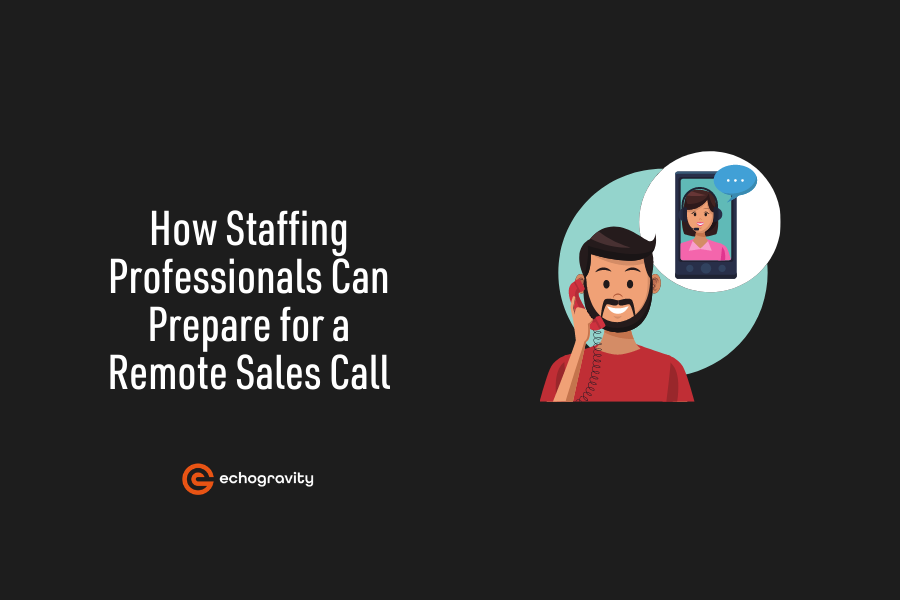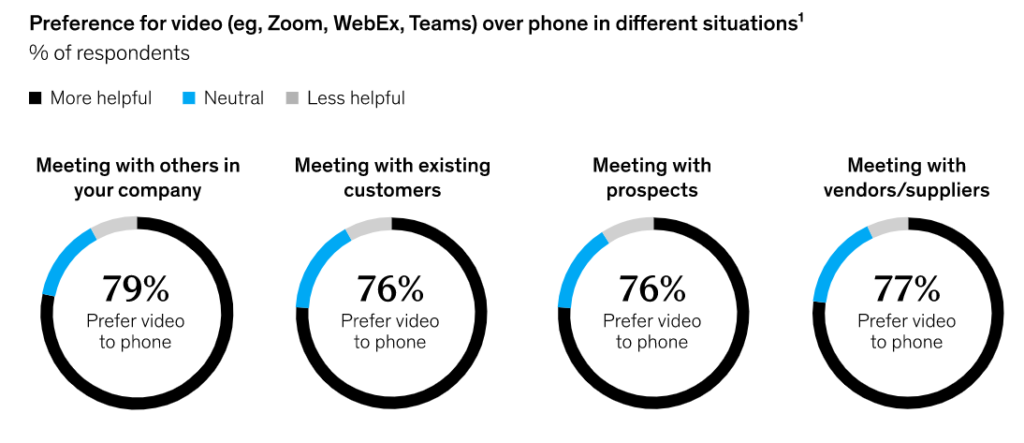How Staffing Professionals Can Prepare for a Remote Sales Call

6 months ago, the outlook for the staffing industry was rocky. Companies worldwide hit the pause button on recruiting and hiring, and temporary staffing revenue was down in every industry except for travel nursing. However, as we look ahead, we’re encouraged to see that the staffing landscape looks more positive, with a faster rebound from the economic impact of the pandemic than anyone expected.
That’s the good news. But challenges remain. Even as the economy shows signs of recovery (and hopefully avoids any double-dip recession), the social impact of COVID-19 will persist into the future. Beyond the now-familiar social distancing and quarantines, the business world continues to grapple with remote communication—particularly for salespeople. How staffing professionals interact with clients (and candidates) has likely changed forever. Below we look at some of the repercussions of the pandemic and how that has changed the way staffing professionals prepare for remote sales calls.
Long Term Remote Work
Many companies have decided to make remote work a permanent option for their employees. We get the attraction—at echogravity, our workplace has been remote since day one. As new generations come into the workforce, it’s likely that the number of companies choosing to do so will only increase—regardless of the pandemic.
In a recent McKinsey report, it was found that at current levels of remote work, there are three to four times as many people working from home than there were before the pandemic. These numbers are higher for sectors such as professional services, information, and management. Not surprisingly, this is projected to deeply impact things like consumer spending, transportation, and urban economies—and, of course, communication.
For companies and employees new to the virtual work environment, everyday interaction and communication is going to take some getting used to. And for salespeople, it’s a whole new ball game.
Staffing Sales & Marketing in the Post-COVID Era
Historically, the staffing industry has been slow to evolve its processes and best practices. But COVID-19 has been one giant catalyst for the entire business world to change how it works. When face-to-face interaction is taken away, we are left with digital means of communication—which goes deeper than Zoom meetings.
Inbound marketing, brand awareness, search engine optimization, and more are all tools and practices to leverage in this post-COVID era. These are the first steps to get on your prospects’ radars and get their attention before you ever make that first call. For more on what this looks like, check out our recent article: Hiring Is Finally on the Rise but How Has COVID-19 Changed Staffing Sales?
With or without a strong marketing foundation, a robust web-conferencing tool is now a non-negotiable. It can also give you the advantage—another McKinsey study shows that the majority of B2B buyers prefer video-based meetings and believe they are more effective than phone conversations. Furthermore, revenue generated from video-related interactions has increased by 69 percent since April 2020.
Preparing for Remote Sales Calls
So what does it actually look like in practice to prepare for remote sales calls? First, it should go without saying that you need a distraction-free environment; take advantage of the background blur feature on most video tools, and ensure your network connection is strong enough and functioning properly.
The advantage of video calls over the traditional phone call is that it gives you the opportunity to read facial expressions and body language. Brush up on your nonverbal communication cues so you can better navigate the conversation. Beyond that, make sure you consider the following factors:
Intelligence, intelligence, intelligence
Data and information are key. Jumping into a call without knowing as much as possible about your prospect and their organization is going to get you nowhere.
Dig into Google, LinkedIn, Glassdoor, and the company website for as much information as you can gather. Find out key individuals within the organization, and as many other aspects as possible—their tech stack, org charts, history, mergers and acquisitions, new hires and open positions, new services or verticals, awards and accolades, and more. This will also serve to give you a good sense of their company culture and values.
With this foundation, you can add greater value to the conversation and even anticipate some of their pain points and goals.
Differentiators
Make sure that your key messages, differentiators, and pitch are aligned with the prospect’s perceived needs. Communicating general features, services, or differentiators that are not in line with their pain points, or, worse, are what everyone else says, will ensure you’re quickly forgotten.
You have one shot to hit the mark. What makes your company and services different? What enables you to better understand your prospects’ challenges and objectives? Why do existing clients work with you? What value can you deliver? Synthesizing these aspects into your pitch and proposal will help you stand out from the competition.
Agenda
Prepare a pre-call plan and agenda. Control the meeting by asking specific open-ended questions and listening carefully in order to ask follow-up questions as necessary. This is where your pre-call research will be valuable—you can avoid asking any basic questions that were already answered on their website and go deeper right off the bat. How do their business goals inform their hiring goals? How has the pandemic impacted their hiring plans—or even their job descriptions? How is success measured and what career backgrounds or qualities do their A-players typically share?
Make sure you have an end in mind for the call. There should be a clear next step that includes your prospect—for example, it’s a good idea to go ahead and get the next call on the calendar right there and then. Set expectations accordingly and emphasize the importance of two-way communication throughout the entire recruitment and hiring process.
Follow Up
Sending a thank you and follow up email is a must. It’s a good opportunity to remind your prospect of the next steps while staying top of mind. Make sure your email includes all of your contact information. And don’t be afraid of including a little personality—for many salespeople, written communication is more challenging than simply talking over phone or video; try to use a “natural” voice in your email to avoid sounding too “sales-y.”
Remote Sales Calls in a Post-Pandemic World
COVID-19 has forced staffing firms to massively overhaul their processes and best practices. But in many ways, we’re better positioned than ever to reach our prospects and align with their pain points. When you’re prepared for that remote sales call, you’re much more likely to close the deal!
WHAT’S YOUR SALES STRATEGY FOR THE POST-COVID MARKET? DROP US A LINE AND LET’S CHAT ABOUT IT.
